Prevalence of root stumps of primary teeth in paediatric patients
Abstract
The purpose of this study is to find negligence of early dental treatment. This research fulfils by providing insight on parents' care towards the child. The aim of our study is to find the prevalence of root stumps of primary teeth in pediatric patients. The current study was a comparative, descriptive and retrospective study which was performed under a university setting where all the data of patients with root stumps of primary teeth were collected by reviewing patients records and analysed the data of 86000 patients between June 2019 to March 2020. The collected data were tabulated; statistical analysis was done by SPSS – IBM. The study showed that out of 2360 extractions, 35 (1.5%)was found to be root stumps of primary teeth. The root stumps were more prevalent among four years of age (42.86%) with female predilection (81.25%) and the higher incidence with maxillary 2nd molars (11.4%). The prevalence of tooth loss was found to be high in children as well as the adults so dental professionals should utilize the various measures and protocols available in preventive dentistry to minimise the effects of tooth loss.
Keywords
Extraction, root stumps, primary teeth, paediatric patients, early childhood caries
Introduction
Tooth loss is the terminal event in the life of a tooth (Packiri, 2017). It is a frequent episode which occurs in an individual who is uncared for and neglected poor oral cavity (Caldas, Marcenes, & Sheiham, 2000; Mathur & Nath, 1968). The prevention of tooth loss is the most important function in the dental profession (Murray, Locker, & Kay, 1996). Tooth loss is the ultimate barometer of failure or success in dentistry and also in dental health programs (Al-Shammery, Guile, & EI-Backly, 1990; Murray et al., 1996). Success is measured by declining rates of edentulism and an increase in the number of retained teeth (Ong, 1998). Tooth extraction appears to be mainly in response to the need for early treatment and when there is a great accumulated need for treatment, patients increasingly select extraction of teeth as the first treatment of choice rather than restorative procedures (Mathur & Nath, 1968).
The reason for extraction of teeth include dental caries (Ekanayaka, 1984; Luan, 1989; Morita, 1994) and its sequelae (pulpitis and periapical infections), periodontal diseases, (Ekanayaka, 1984; Ong, Yeo, & Bhole, 1996) fractured teeth, malpositioned teeth, impacted teeth, orthodontic treatment, retained deciduous teeth, prosthetic considerations, supernumerary teeth, and preparation for radiotherapy (Ekanayaka, 1984; Oginni, 2005; Ong et al., 1996). Root stumps are defined as the fracture of the tooth(i.e.)after the crown of the tooth is completely broken off or rotted away. Root stump is a part of the developmental anomaly in a post-inflammatory condition (Khashu, Baiju, & Yadav, 2012). Maxillary root stumps are challenging to extract and they can only be viewed by an indirect vision and blood oozing out of the socket obstructs the vision (Packiri, 2017).
Despite the relative abundance of studies documenting the reasons for extraction of mixed dentition, very little information exists describing their reasons for the extraction of primary teeth (Dülgergil, Dalli, Hamidi, & Çolak, 2013). In order to develop strategies for the future, the reduction in tooth loss, it is important to understand the factors which lead to such tooth loss and their relative contributions. The need of this study is to find negligence of early dental treatment. This research fulfils by providing insight on parents' care towards the children. The aim of our study is to find the prevalence and incidence of root stumps of primary teeth in paediatric patients.
Materials and Methods
The current study was a comparative, descriptive, retrospective study where all the required data of the patients with root stumps of primary teeth was collected by reviewing patients records and analysed the data of 86000 patients reported to the dental Institution was obtained. The study was conducted in a university setting. The pros of the study were that it included a varied population and had the ability to perform preference analysis. The cons of our study were it had a limited geographic area of coverage and small sample size. The ethical approval was obtained from the Institutional Ethical Committee(ethical approval number: SDC/SIHEC/2020/DIASDATA/0619-, 0320). The selection of patients was from the list of paediatric outpatients of age groups between 0-12 years who visited the clinic from the month of June 2019 - March 2020. The data were collected from reviewing the records of all the treatments done to children in the Department of Paediatric dentistry which was offered by the university. The inclusion criteria were all patients between 0-12 years of age whose clinical examination revealed root stumps of primary teeth. Incomplete and censored data, extractions other than root stumps were excluded. The total sample size of the study obtained was 2500. All 2500 case sheets were cross verified with photographs and reviewed by additional reviewers. To minimise sampling bias, a simple random sampling method was used. The final sample size of the patients who underwent extraction in primary teeth was found to be 2360. The data had high internal validity and low external validity. The data was entered in a methodological manner and it was tabulated in an excel sheet. The tabulated data was imported and compiled for statistical analysis using SPSS software.
Results and Discussion
In the current study, the total number of extraction done in primary teeth among 0-12 years of age was found to be 2360 (98.5% ), Bar graph shows that out of 2396 extractions, out of which only 36(1.5%) was found with an incidence of root stumps in primary teeth [Figure 1]. Figure 2 denoted the prevalence of root stumps of primary teeth among different age groups. The result of our study showed root stumps were more prevalent among the four years of age (42.86%).(Chi-square test p=0.00 - statistically significant ). Figure 3 represented the prevalence of gender in relation to root stumps. The total subjects of root stumps examined were 36 of which males constituted(18.75%) and females(81.25%).Prevalence of root stumps of primary teeth was higher in females compared to males (82.86%). (Chi-square test p=0.00 - statistically significant ). Figure 4 Bar graph shows that the maxillary primary 2nd molar was found to be more prevalent compared to other teeth(11.43%). (Chi-square test ; p=0.74 - statistically not significant) and denoted the prevalence of root stumps among different tooth numbers. The results showed the tooth number right primary maxillary lateral incisors (5.2%), right primary maxillary canine (2.9%), right primary maxillary molars (11.4%), left primary maxillary lateral incisors (5.7%), left primary maxillary canines ( 2.9%), left primary maxillary first molar (8.6%), left primary maxillary second molar (11.4%), left primary mandibular lateral incisors (2.9%), left primary mandibular canine (2.9%), left primary mandibular first molar (11.4%), left primary mandibular second molar ( 5.7%), right primary mandibular lateral incisors (2.9%), right primary mandibular canine (2.9%), right primary mandibular first molar (8.6%), right primary mandibular second molar (2.9%). The correlation between the gender of the patient and the tooth number of root stumps of permanent teeth is shown in Figure 5. The chi-square test showed no statistical significance (p=0.868).
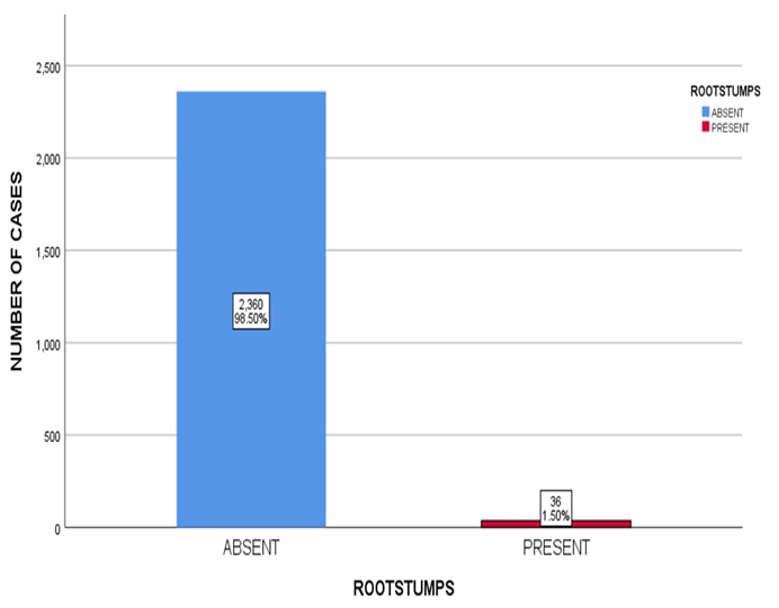
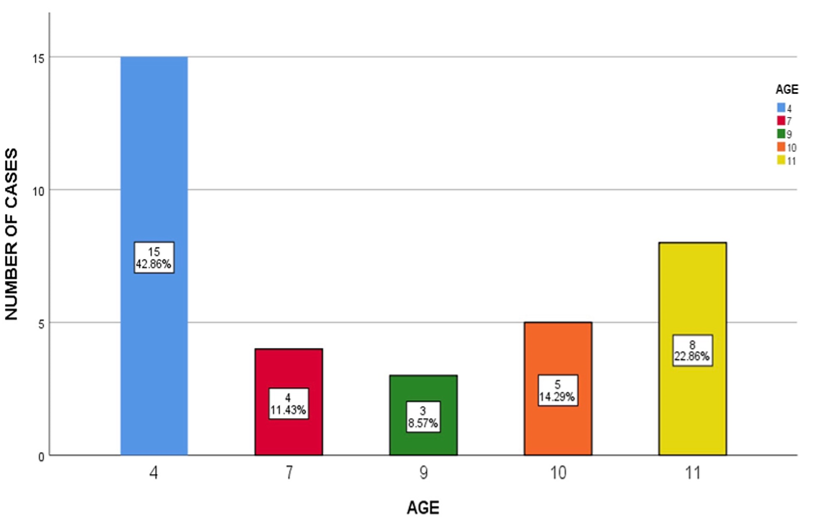
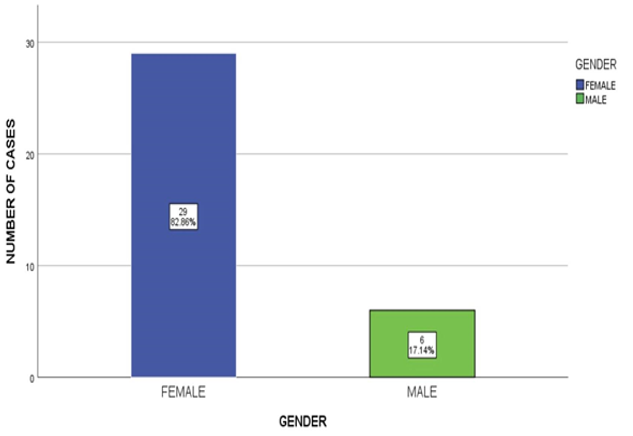
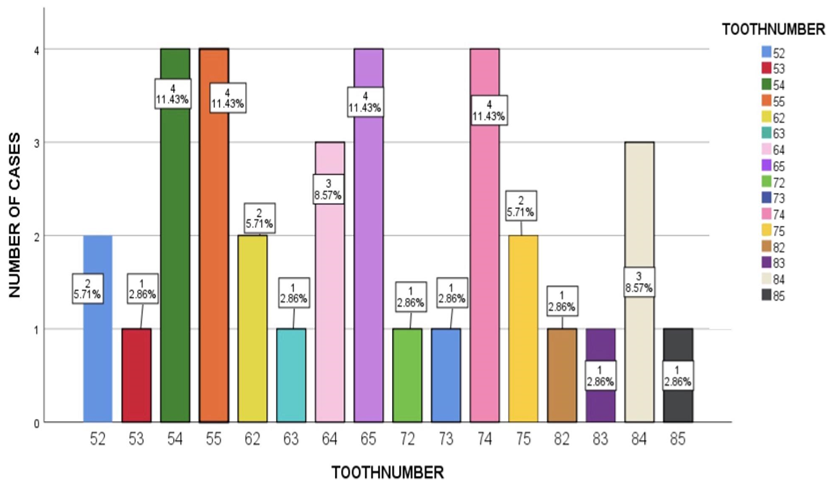
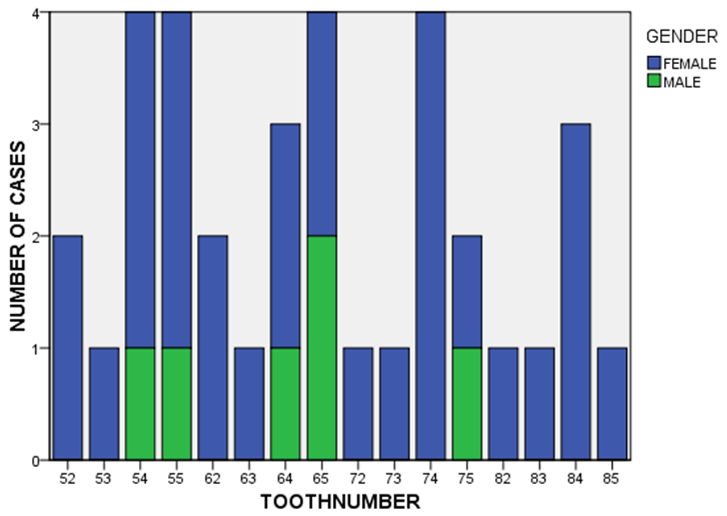
Early childhood caries (ECC) was the public health problem in both developing and industrialized countries (Jeevanandan, 2017; Panchal, Jeevanandan, & Subramanian, 2019). ECC can begin early in life, progresses rapidly in those who are at high risk, and often untreated (Jeevanandan & Govindaraju, 2018). Maintaining good oral health helped the older adults to prevent a variety of health problems and disabilities (Govindaraju, Jeevanandan, & Subramanian, 2017; Ravikumar, Jeevanandan, & Subramanian, 2017). Inflicted children are associated with health problems, ranging from local infections to oral pain and also leads to difficulty in eating and sleeping, reduced growth and also change in the behaviour (Govindaraju, Jeevanandan, & Subramanian, 2017; Panchal et al., 2019). Oral rehabilitation consists of restoration or surgical removal of carious teeth along with recommendations regarding feeding habits (Christabel, 2015; Govindaraju, Jeevanandan, & Subramanian, 2017). Primary prevention of ECC had been restricted to counselling parents regarding proper feeding behaviour, oral hygiene measures and new strategies that address the infectious component through the use of topical antimicrobial therapy in order to defeat this common oral affliction. (Gurunathan & Shanmugaavel, 2016; Nair, 2018).
Tooth loss reflects major public health in many developing countries (Susin, Haas, Opermann, & Albandar, 2006). Prevalence of root stumps in primary teeth was found to be (1.5%). The main reason for the root stumps in primary teeth was due to a cariogenic diet, poor oral hygiene, grossly decayed primary teeth (Govindaraju, 2017; Somasundaram, Ravi, Rajapandian, & Gurunathan, 2015). So, early prevention and better oral hygiene habits would result in a less tooth destruction and less prevalence of root stumps of primary teeth in paediatric patients (Gurunathan & Shanmugaavel, 2016; Subramanyam, 2018). There was no supportive or contradictory literature with respect to the current study (Ramakrishnan & Shukri, 2018).
The present study indicated that there are predisposing variables which are associated with root stumps. Age was a predisposing factor associated with root stumps (Govindaraju, 2017). Root stumps are more prevalent in children among four years of age. The reason for root stumps among four years of age was found to be poor oral hygiene maintenance and early childhood caries. The results of this study are in agreement with previous studies done by Bansal (2017), revealed that carious teeth are more prevalent among the 4 to 12 years of age (Bansal, 2017; Susin et al., 2006). Similarly, the study conducted by Brown et al. 2000 showed a contradictory result in relation to our study. In his study, he found that carious teeth among 2 - 10 years of age were found to be decreased (Brown, Wall, & Lazar, 2000).
Gender was another predisposing variable which was associated with root stumps. The present study revealed that females (81.25%) had more number of root stumps compared to (18.75%) of males. The reason was found to be a cariogenic diet with poor oral hygiene leads to gross destruction of teeth (Caldas et al., 2000; Mathur & Nath, 1968). The findings of our study were similar to studies conducted by Bansal (2017), found that females had greater tooth loss compared to males in an urban population (Bansal, 2017). In our study showed that the maxillary 2nd molar (11.4%) was more prevalent than other teeth. The reason for molar prevalence was found to be food impaction. Brown et al. 2000, in his study, mentioned that decay was more common in molars which showed similar results to our study (Brown et al., 2000). The chi-square test was obtained in our study between gender and tooth number was found to be statistically insignificant. The limitations of our study are, the study was unicentered with a limited demographic area of smaller sample size.
Conclusion
Within the limitations of the current study, it was found that root stumps are more common among four years of age. Also, there was a higher prevalence among females with Maxillary 2nd primary molars being the most commonly involved teeth. Concern over dietary intake needs to be affirmed at the earliest to prevent complete damage to the primary dentition.
Acknowledgement
The authors of this study acknowledge the institute, for their help towards collecting all the patient case records and other data in relevance to the current study.
Conflict of Interest
The authors declare that there are no conflicts of interest for this study.
Funding Support
The authors declare that they have no funding support for this study.